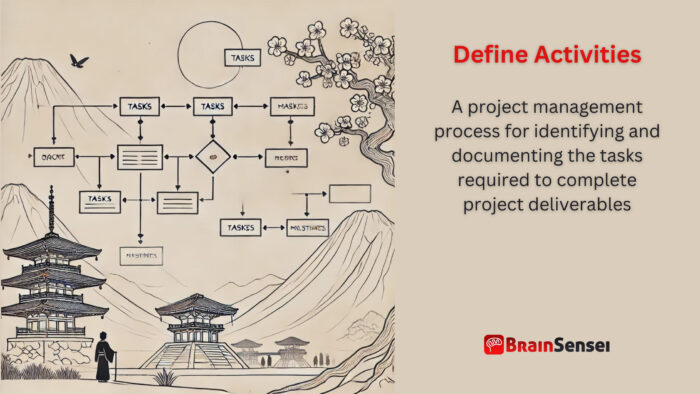
Define Activities
What is Define Activities?
Define activities is a project management process for identifying and documenting the tasks required to complete project deliverables. This process is crucial for establishing a clear project schedule, ensuring that every necessary action is accounted for, and facilitating efficient resource allocation.
Key Takeaways
- Core Planning Process: Essential for building a detailed project schedule.
- Work Breakdown Structure (WBS) Integration: Relies heavily on the WBS to identify activities.
- Clarity and Accountability: Ensures clear task assignments and accountability.
- Foundation for Sequencing: Precedes the Sequence Activities process.
- Improved Resource Management: Helps identify necessary resources for task completion.
Understanding Define Activities
How It Works
Define Activities involves breaking down the project’s work packages into clear, specific, and measurable individual tasks. Project managers often accomplish this using tools like the Work Breakdown Structure (WBS), expert judgment, and decomposition techniques. The activities identified during this process become the foundation for scheduling, resource allocation, and tracking project progress.
- Input Gathering: Collect information from the project scope, WBS, and project management plan.
- Decomposition: Break down work packages into more minor, actionable activities.
- Document Activities: Create a detailed activity list and activity attributes.
- Milestone Identification: Establish key milestones for tracking progress.
- Validation: Ensure the activities align with project deliverables and goals.
Notes
- Overlooking activities can lead to schedule delays.
- Activities should be distinct and non-overlapping.
- Project management software can streamline the Define Activities process by providing a platform for input gathering, decomposition, and activity documentation. These tools can help project managers and teams collaborate more effectively, track progress, and make real-time adjustments, enhancing the process’s efficiency and accuracy.
- Involving team members during the decomposition process is crucial for enhancing the accuracy and completeness of the activity list. Their domain expertise and on-the-ground experience help identify overlooked tasks and ensure the list is comprehensive and realistic.
Related Terms
- Work Breakdown Structure (WBS): A hierarchical decomposition of the project scope into smaller, manageable components.
- Activity List: A comprehensive list of all activities necessary to complete the project.
- Activity Attributes: Details providing more information about each activity, such as resources and duration.
- Sequence Activities: The subsequent process to logically arrange activities.
- Milestone List: A record of significant project checkpoints.
Examples of Define Activities
Manufacturing Industry
A manufacturing company launching a new product uses Define Activities to break down tasks like product design, material procurement, and prototype testing. The process ensures all steps are documented, sequenced, and resourced effectively to meet the production timeline. The project manager starts by gathering inputs from the project charter, scope statement, and WBS. Using decomposition techniques, they identify tasks such as designing product schematics, sourcing raw materials, setting up production lines, testing prototypes, and preparing for mass production. The project manager assigns tasks to specific teams with precise deadlines and resource requirements. They conduct regular reviews and adjustments to address unforeseen challenges, such as supplier delays or design revisions.
IT & Software Industry
An IT project to develop a new mobile app employs Define Activities to detail tasks such as coding, UI design, and system testing. The process begins with workshops involving developers, designers, and stakeholders to identify essential activities. The team documents tasks like front-end development, back-end integration, quality assurance testing, and deployment planning. The team also outlines dependencies, such as completing database setup before coding can commence. By clearly defining these activities, the project team can set realistic deadlines and allocate resources efficiently. Regular activity list updates help accommodate new features or technical adjustments as the project progresses.
Government & Public Services
A public infrastructure project, such as building a new highway, uses Define Activities to outline tasks like environmental assessment, land acquisition, and construction phases. The process starts with a thorough review of regulatory requirements and project scope. Key activities include conducting environmental impact studies, negotiating with property owners, securing permits, preparing construction sites, and overseeing building work. The team divides each activity into smaller tasks, such as soil testing and selecting pavement material. Regular stakeholder meetings ensure that activities align with public needs and legal standards. Proper activity definition ensures compliance with regulations and timely completion.
These examples demonstrate how to define activities that support project clarity, resource optimization, and schedule accuracy across different industries.
Use Cases for the Define Activities Process
United States (Construction Project)
A construction firm in Texas undertakes a commercial building project. The Define Activities process helps the team detail excavation, foundation laying, and structural assembly tasks, enabling accurate scheduling and workforce allocation. The project starts with gathering inputs from the project charter and scope statement. The project manager uses decomposition techniques to identify all necessary tasks, from site preparation to interior finishing. Detailed activity attributes, such as required materials, labour skills, and estimated durations, are documented. The activity list is then integrated into the project schedule, ensuring that tasks like concrete curing are logically sequenced. Regular team meetings review task progress and address emerging challenges, such as adverse weather conditions or supply chain delays.
Germany (Healthcare IT Implementation)
A hospital in Germany implements new healthcare software. The Define Activities process begins with identifying the primary deliverables: a fully integrated electronic health record (EHR) system. The team uses the WBS to break down work packages into tasks like software installation, data migration, user training, and system testing. The project manager assigns each task to appropriate teams, with explicit dependencies and documentation of resource requirements. The activity list helps the project manager track progress, ensuring the completion of tasks like database configuration before system integration starts. The project addresses challenges such as regulatory compliance and staff availability through continuous communication and task adjustments.
India (Telecommunications Infrastructure)
A telecom company in India rolls out a 5G network. The Define Activities process starts with a high-level WBS, breaking the work into manageable tasks such as site selection, equipment procurement, and network testing. The team documents each task with attributes like duration estimates, resource requirements, and interdependencies. The project team uses scheduling software to visualize task relationships and ensures the completion of tower installation before network optimization begins. Regular site visits and stakeholder meetings provide feedback on task progress. The project manager periodically reviews and updates the activity list to accommodate new technological requirements or external factors like regulatory changes.
These use cases illustrate the versatility and importance of the Define Activities process in different industries and regions, highlighting its role in ensuring structured, efficient, and adaptable project execution.
Best Practices When Defining Activities
Effective implementation of Define Activities requires careful planning, attention to detail, and adherence to proven techniques. Here are some best practices for optimizing this process:
Involve Key Stakeholders in Early
Engage stakeholders from various departments during the activity definition process. Their insights are invaluable in identifying overlooked tasks and ensuring alignment with organizational goals, making them feel involved and integral to the project’s success.
Use Decomposition Techniques
Break down work packages into manageable activities. Techniques like progressive elaboration and rolling wave planning can be particularly effective in complex projects.
Document Activities Clearly
Ensure that each activity has a clear, concise description. Include essential details such as expected duration, required resources, and dependencies to facilitate better scheduling and monitoring.
Leverage Project Management Software
Utilize tools like Microsoft Project, Primavera P6, or Trello to streamline activity definition, documentation, and tracking. These tools help visualize activity relationships and track progress in real time.
Integrate Activities into the Project Schedule
Incorporate activity definition into the overall project schedule. Use techniques like critical path analysis to identify task dependencies and optimize resource allocation.
Review and Update Regularly
Project scopes can evolve, necessitating regular reviews of the activity list. Periodic updates help maintain schedule accuracy and prevent task omissions.
Assign Ownership and Accountability
Clearly define who is responsible for each activity. Assigning ownership helps ensure accountability and enhances task completion rates.
Consider Risks and Uncertainties
Identify potential risks associated with each activity. Develop contingency plans to address possible disruptions and minimize their impact on the project timeline.
Conclusion: By adhering to these best practices, project managers can enhance task clarity, improve resource allocation, and increase the likelihood of project success. Neglecting this process can result in missed activities, resource bottlenecks, and schedule overruns, ultimately jeopardizing project outcomes.
Common Mistakes and Issues
Defining activities is critical but prone to mistakes if not meticulously executed. One major issue is the incomplete decomposition of tasks. For instance, a retail company implementing a new inventory management system overlooked data migration as a critical task. This initial omission became apparent only during system testing, causing costly delays and additional resource allocation.
Another frequent mistake is a lack of stakeholder involvement during the activity definition process. Excluding key stakeholders can lead to missing essential tasks or misunderstanding specific requirements. For example, a construction project in Canada faced significant rework costs when the team failed to consult the project sponsors about interior design specifications.
Moreover, relying solely on historical data without considering project-specific nuances can lead to inaccuracies. In a healthcare IT project in South Africa, assumptions based on previous implementations resulted in underestimated task durations and staffing needs, ultimately jeopardizing project delivery timelines.
To avoid these pitfalls, project managers must adopt a systematic approach, utilizing expert judgment, historical data, and contemporary project tools to validate the activity list comprehensively. They should also schedule regular reviews and updates to adapt to evolving project dynamics and prevent activity omissions.
Frequently Asked Questions (FAQs)
Why is Define Activities important in project management?
The Define Activities process identifies and documents all tasks required to complete project deliverables, forming the basis for accurate scheduling and resource allocation.
What tools does the Define Activities process usually use?
Project managers often use tools like Work Breakdown Structures (WBS), decomposition techniques, and project management software such as Microsoft Project or Primavera.
How does Define Activities relate to Sequence Activities?
Define Activities identifies and documents tasks, while Sequence Activities determines the logical order of these tasks.
What are activity attributes?
Activity attributes provide detailed information about each activity, including resources, duration, and dependencies.
Can Define Activities be revised?
The team should review and update the activity list as the project progresses and new information becomes available.
Additional Resources
- Planning Process Group Activities
- Aspects of a Work Breakdown Structure (WBS)
- Work Breakdown Structure (WBS)
Preparing for a PMI certification?
- Exam Prep Courses: PMP®, CAPM®, and PMI-ACP®
- Exam Simulators: PMP®, CAPM®, PMI-ACP®, PMI-PBA®, PMI-RMP®, PMI-SP®, PgMP®, and PfMP®
- Professional Development Units (PDUs): 15, 30, and 60 PDU Bundles



